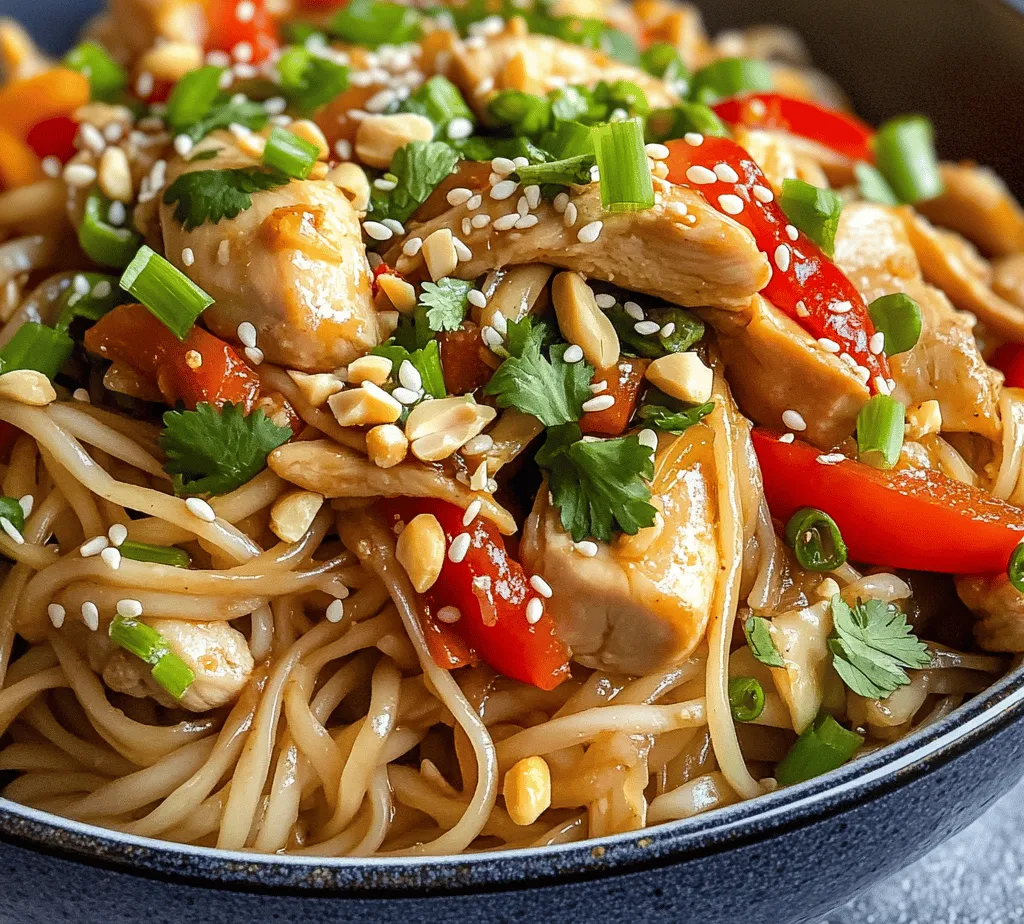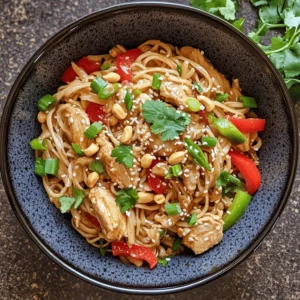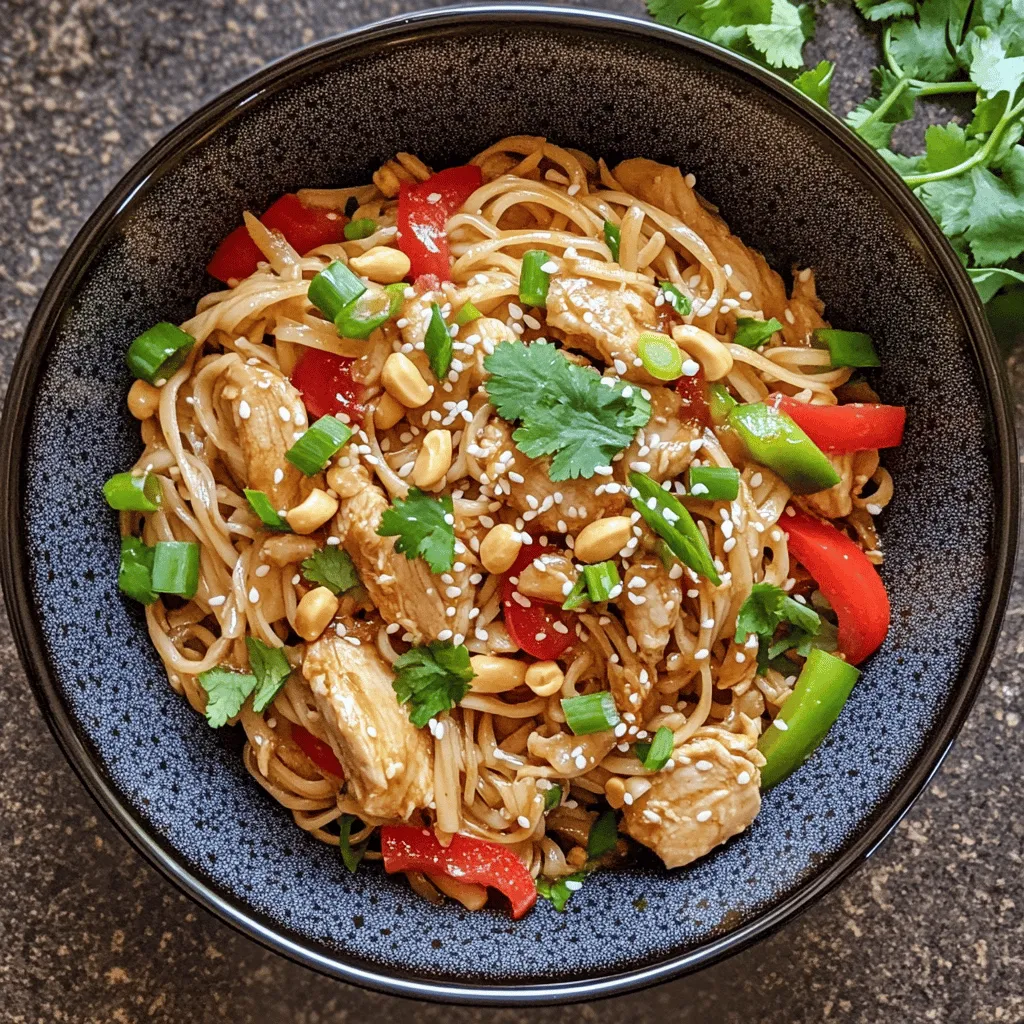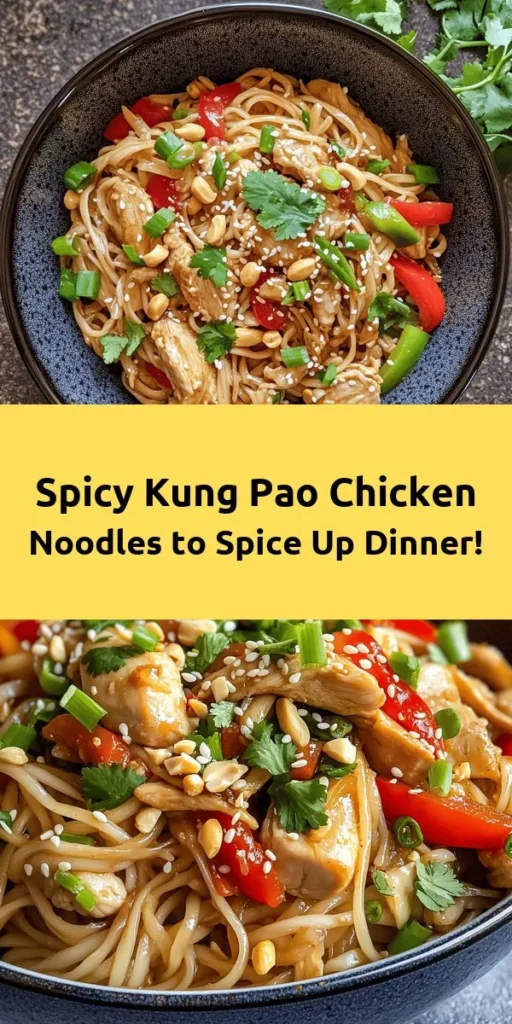Introduction
In the realm of culinary delights, few dishes can boast the perfect harmony of flavors, textures, and aromas quite like Kung Pao Chicken Noodles. This beloved fusion dish marries the spicy, savory essence of traditional Kung Pao chicken with the delightful chewiness of rice noodles, creating a meal that is both comforting and invigorating. Originating from the rich tapestry of Chinese cuisine, Kung Pao chicken has long been a favorite in households and restaurants alike, celebrated for its ability to balance heat with sweetness and crunch.
Kung Pao Chicken Noodles elevate this classic dish by introducing noodles that absorb the flavorful sauce, ensuring that every bite is a delightful explosion of taste. What sets this dish apart is its versatility; it can be easily customized to suit individual preferences, whether you prefer more vegetables, a different protein, or varying levels of spice. The combination of tender chicken, vibrant vegetables, crunchy peanuts, and the rich umami of sauces creates a tantalizing experience that keeps diners coming back for more.
This recipe not only showcases the signature flavors of Kung Pao chicken but also highlights the importance of preparation and ingredient selection, essential for achieving an authentic dish that delights the senses.
Understanding the Ingredients
Creating a fantastic plate of Kung Pao Chicken Noodles begins with understanding the key ingredients that contribute to its signature taste and texture. Each component plays a crucial role, and knowing how they interact can elevate your cooking experience.
Rice Noodles
At the heart of this dish are rice noodles, which serve as the perfect base for the bold flavors of Kung Pao. Unlike wheat noodles, rice noodles have a unique texture that is both soft and slightly chewy, making them ideal for soaking up sauces. Their ability to absorb flavors means that each strand of noodle is infused with the savory essence of the Kung Pao sauce, enhancing the overall taste of the dish. When cooked correctly, rice noodles provide a delightful contrast to the crunchy vegetables and peanuts.
Chicken Breast
Chicken breast is the preferred protein for Kung Pao Chicken Noodles, offering a lean and versatile option that cooks quickly and absorbs marinades effectively. Not only is chicken breast a good source of protein, but it also contains essential nutrients, including B vitamins and minerals. When prepared correctly, chicken breast remains juicy and tender, adding a satisfying component to the dish. In this recipe, the chicken is marinated to maximize flavor and tenderness before being stir-fried to perfection.
Soy Sauce, Rice Vinegar, and Hoisin Sauce
The trio of soy sauce, rice vinegar, and hoisin sauce is crucial for achieving the authentic flavor profile of Kung Pao Chicken Noodles.
– Soy Sauce: This fermented condiment provides the umami depth that is characteristic of many Asian dishes. It adds saltiness and richness, enhancing the overall flavor without overwhelming the other ingredients.
– Rice Vinegar: Offering a mild acidity, rice vinegar brightens the dish and balances the richness of the sauces. Its subtle sweetness complements the other flavors, making it an essential ingredient in marinades and stir-fries.
– Hoisin Sauce: Known for its sweet and savory flavor, hoisin sauce adds complexity to the dish. Its thick consistency helps to create a luscious sauce that clings to the noodles and chicken, ensuring every component is coated in flavor.
Chili Paste
For those who enjoy a bit of heat, chili paste is an essential addition to Kung Pao Chicken Noodles. This ingredient allows you to tailor the spice level to your liking. Whether you prefer a mild kick or a fiery punch, chili paste can be adjusted to suit your taste. Common options include sambal oelek or a homemade chili garlic sauce, each offering its unique flavor profile.
Vegetables
Fresh vegetables not only add vibrant colors to your dish but also contribute vital nutrients and textures. Bell peppers, zucchini, and snap peas are excellent choices for Kung Pao Chicken Noodles, providing a satisfying crunch and a pop of flavor. These vegetables can be easily customized based on seasonal availability or personal preference, making the dish adaptable throughout the year.
Peanuts
One of the defining features of Kung Pao chicken is the addition of peanuts. These crunchy morsels bring a delightful creaminess and texture that contrasts beautifully with the tender chicken and soft noodles. Not only do they enhance flavor, but they also contribute healthy fats and protein, making the dish more filling and nutritious.
Fresh Garnishes
To elevate the presentation and flavor of your Kung Pao Chicken Noodles, fresh garnishes are a must. Chopped green onions and cilantro provide freshness and brightness, while toasted sesame seeds add an appealing crunch. Not only do these garnishes enhance the visual appeal of the dish, but they also offer additional layers of flavor that make each bite more enjoyable.
Preparation Steps for Kung Pao Chicken Noodles
Once you have gathered all your ingredients, it’s time to dive into the preparation of this exciting dish. The steps involved in making Kung Pao Chicken Noodles are straightforward but require attention to detail to ensure the best results.
Preparing the Rice Noodles
1. Select the Right Rice Noodles: Choose flat rice noodles, often labeled as “pad thai noodles” or “rice stick noodles.” These are typically available in the Asian aisle of your local grocery store.
2. Cooking the Noodles: Begin by boiling water in a large pot. Once the water reaches a rolling boil, add the rice noodles and stir gently to prevent them from sticking together. Cook according to the package instructions, usually around 4-6 minutes, until they are al dente.
3. Refreshing the Noodles: Once cooked, promptly drain the noodles in a colander and rinse them under cold water. This stops the cooking process and helps to remove excess starch, preventing the noodles from becoming gummy.
4. Toss with Oil: To keep the noodles from sticking, drizzle a little sesame oil or vegetable oil over them and toss gently. This not only prevents clumping but also adds a bit of flavor.
Marinating the Chicken
1. Cutting the Chicken: Start with boneless, skinless chicken breasts. Slice the chicken into bite-sized pieces or strips to ensure even cooking.
2. Creating the Marinade: In a bowl, combine soy sauce, rice vinegar, and a spoonful of hoisin sauce. This mixture will infuse the chicken with flavor and help tenderize it. For added depth, consider incorporating minced garlic and ginger into the marinade.
3. Marinating Time: Allow the chicken to marinate for at least 15-30 minutes. This step is crucial as it allows the flavors to penetrate the meat, resulting in a more flavorful dish. For optimal results, marinate for up to two hours in the refrigerator.
4. Preparing for Cooking: After marinating, remove the chicken from the bowl and let any excess marinade drip off. This will ensure that the chicken sears properly in the pan, creating a delicious crust.
Importance of Timing
Timing is key when cooking Kung Pao Chicken Noodles. Each component should be prepared and cooked in a manner that ensures everything is hot and fresh when served. Here are some tips to keep in mind:
– Stir-Frying: The chicken should be stir-fried over high heat to achieve a nice sear while keeping it moist. This should take about 4-5 minutes, depending on the thickness of the chicken pieces.
– Vegetable Cooking: Add the vegetables to the pan shortly after the chicken is cooked, allowing them to retain their crunch. This step should take no longer than 3-4 minutes.
– Combining Ingredients: Finally, once the chicken and vegetables are cooked, toss in the cooked rice noodles and pour over the prepared sauce. Stir everything together for about 2 minutes until the noodles are heated through and well-coated in sauce.
By following these preparation steps and understanding the role of each ingredient, you’ll be well on your way to creating a delicious plate of Kung Pao Chicken Noodles. The combination of vibrant flavors and satisfying textures in this dish is sure to impress both family and friends, making it a perfect choice for any occasion.

Stir-Frying the Vegetables
Once your chicken is marinated and ready, it’s time to stir-fry the vegetables, which play a crucial role in adding both flavor and texture to your Kung Pao Chicken Noodles. For stir-frying, high heat is essential. Using a wok or a large sauté pan allows for even heat distribution, ensuring that the vegetables cook quickly without becoming soggy.
To maintain the vibrant color and crunch of your vegetables, it’s vital to keep your cooking time short. Start by adding heartier vegetables like bell peppers and carrots, which take a little longer to cook. Stir-fry these for about 2-3 minutes until they start to soften but still retain their crispness. Follow with quicker-cooking vegetables such as zucchini and snow peas, adding them for an additional 1-2 minutes. This staggered approach not only enhances the texture but also creates a colorful medley that is visually appealing.
Cooking the Chicken
After your vegetables are perfectly stir-fried, it’s time to focus on the chicken. The key to achieving that perfect browning and texture lies in the cooking technique. Ensure your pan is very hot before adding the chicken; this will help sear the meat quickly, creating a delicious outer crust while keeping the inside tender and juicy.
When adding the chicken pieces, avoid overcrowding the pan. Too much chicken in a small space will lower the pan’s temperature, resulting in steaming rather than searing. Cook in batches if necessary, allowing each piece to get that golden-brown finish.
Garlic and ginger are staples in Kung Pao Chicken and play a significant role in enhancing the dish’s flavor profile. After the chicken has browned, add minced garlic and ginger to the pan. Sauté these aromatics for about 30 seconds until fragrant, being cautious not to burn them, as this can lead to a bitter taste.
Combining Ingredients
Now that your chicken and vegetables are cooked to perfection, it’s time to bring everything together. To combine the chicken and vegetables with the noodles, use a gentle tossing technique. Gently fold the ingredients rather than stirring aggressively, which can break the noodles. The goal is to create a harmonious mix where every bite contains a bit of each component.
Drizzle your prepared sauce over the mixture, ensuring it coats all the elements evenly. The sauce not only adds flavor but also helps bind the ingredients together. Toss everything together for another 1-2 minutes, allowing the noodles to absorb some of the sauce while ensuring that the flavors meld beautifully.
Finishing Touches
Before serving your Kung Pao Chicken Noodles, it’s essential to adjust the seasoning. Taste your dish and consider whether it needs a touch more soy sauce, a pinch of salt, or a dash of vinegar to balance the flavors. The final mix will be enhanced by the addition of crushed peanuts and chopped green onions, which add a delightful crunch and fresh flavor. Stir these in just before serving to maintain their texture.
Serving Suggestions for Kung Pao Chicken Noodles
Presentation is key when it comes to serving Kung Pao Chicken Noodles. Serve the dish in a large bowl or on a platter, garnishing it with additional green onions and a sprinkle of sesame seeds for an appealing visual touch. Consider using chopsticks for a traditional feel, or offer forks for convenience.
Pair your Kung Pao Chicken Noodles with sides like steamed broccoli or a light cucumber salad for a refreshing contrast. A crisp white wine or a light lager can complement the dish’s spiciness. For those who prefer non-alcoholic options, a chilled green tea or a refreshing lemonade can work wonderfully to balance the flavors.
Nutritional Insights
Kung Pao Chicken Noodles not only satisfy your taste buds but also offer several nutritional benefits. Chicken is a great source of lean protein, which is essential for muscle growth and repair. The array of colorful vegetables adds essential vitamins, minerals, and antioxidants, contributing to a well-rounded meal.
The peanuts in the dish provide healthy fats and protein, while also adding a delightful crunch. To balance flavors with healthy eating, consider using whole grain noodles for added fiber. This can help keep you feeling fuller longer and regulate blood sugar levels.
Conclusion
In summary, Kung Pao Chicken Noodles are a delicious and satisfying dish that can easily be made at home. The combination of tender chicken, crisp vegetables, and chewy noodles, all enveloped in a flavorful sauce, makes for a meal that is sure to impress.
Don’t hesitate to experiment with the ingredients to match your personal tastes—try swapping chicken for tofu or adding different vegetables based on what you have on hand. The cultural significance of Kung Pao chicken, with its roots in Chinese cuisine, showcases the beauty of culinary adaptation, and this noodle variation is a fantastic way to enjoy a classic dish with a twist.
So gather your ingredients, fire up the wok, and dive into the delightful world of homemade Kung Pao Chicken Noodles. Your taste buds will thank you!



